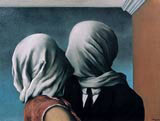Obscure Desire
Gayle Markovitz sheds some light on the design and content of the forthcoming Tate Modern exhibition Surrealism: Desire Unbound

What serendipity for architect MacCormac Jamieson Pritchard to make such a fine job of Southwark Tube station. It has made good use of it, journeying to the Tate Modern to design the Surrealism: Desire Unbound exhibition.
It is unusual for architects to devise exhibitions (London’s Hayward Gallery excepted), and since architecture needs firmer ground to build on than the subconscious, even more surprising to call upon architectural expertise in this instance.
This is a major exhibition of international surrealism, focusing on desire as a key concept of the movement. Influenced by the Freudian notion that the sexual instincts are fundamental to the development of the psyche, desire embraces both the sublime and a dark carnality. It is the stuff of private fantasy and untamed dreams. MJP’s Wellcome Wing at the Science Museum and the Ruskin Library were projects that explored materiality, colour and light, creating spaces that offered an alternative experience of reality. These precedents clearly presented the possibility for venturing into an artificial, dream-like architecture, relevant to the kind of art that is pre-occupied by the unconscious.
Far from being a didactic retrospective, this is a multi-sensual experience that takes the viewer on a journey, where tonal and chromatic contrasts become more intense, as you are led to a dark space at the centre. Desire is presented as a theme with a strong contemporary resonance. Re-emerging, you arrive at daylight and a view of the Thames. It’s like blinking into the real world after an afternoon matinee.
Visitors enter through a dark antechamber that leads to a rose-coloured chamber; following through are grey, yellow, mauve, blue, terracotta and dark purple rooms, separated by large black portals. There is also a black central space and one eloquent and surprising white area housing the archival material in cabinets. The bold relationship between colour and the exhibits themselves is a leap of faith, courtesy of a collaboration between MJP, Dutch lighting design group Hollandslicht and colour consultant Jocasta Innes. The artwork is at the core of all design considerations, and on show are iconic works such as de Chirico’s The Child’s Brain, Max Ernst’s The Robing of the Bride, Dali’s Metamorphosis of Narcissus and Magritte’s The Rape.
The exhibition design is an experiment of colour. What is clear is that it will be a refreshing change from the tectonic starkness of the Herzog and de Meuron-designed Tate Modern, and it will question the convention of the white cube that offers a denial of an interpretive conversation between the environment and the exhibits themselves. It is pertinent that a retrospective of a movement that evolved in the early part of the last century will force us not only to think of the implications for contemporary art, but also to reconsider the ideology of the gallery space. Perhaps it is time we question the neutrality of the gleaming white space.
Surrealism: Desire Unbound shows at the Tate Modern, London SE1, from 20 September until 1 January 2002
-
Post a comment




